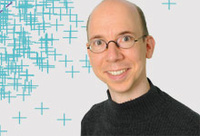CHANNELS
Prof. Johannes Berg
“Statistical modelling leads to novel methods for the analysis of ageing organisms”
Prof. Johannes Berg uses statistical physics to model and analyse information processing in biological systems. He studied physics at Oxford and received his Bachelors in 1995 and Masters in 1996. During his PhD research in Magdeburg, he applied statistical mechanics to problems of game theory. After a period as a postdoctoral research fellow at the International Centre for Theoretical Physics in Trieste, he came to Cologne in 2001, where from 2006 he headed an Emmy-Noether junior research group. In 2007, he was elected to the junior section of the Academy of Sciences Northrhine-Westphalia and also awarded a Mercator Foundation scholarship. He held a position as interrim professor at the Physics Institute of the Albert-Ludwigs University in Freiburg, and today is a professor of theoretical physics at the University of Cologne. His work lies at the boundary of theoretical physics and quantitative biology with a focus on the statistical description of cellular information processing. This research area spans a broad range of statistical physics including stochastic systems, the physics of disordered systems and information theory.
Research interests
- Statistical physics of biological systems
- Bio-molecular networks
- Stochastic dynamics and inference
Previous scientific achievements
Prof. Johannes Berg has contributed to a wide range of interdisciplinary problems in statistical mechanics including game theory, models of markets, and granular materials, before turning to the burgeoning field of biological systems. A statistical approach to networks formulated jointly with Prof. Michael Lässig has allowed the comparative analysis of bio-molecular networks (network alignment) on the basis of statistical models. Subsequent work established a link between gene expression dynamics and out-of-equilibrium statistical mechanics as well as between significant clusters in gene expression data and the statistical mechanics of disordered systems.
Current projects
Work within Sybacol focusses on the statistical analysis of gene expression patterns of ageing organs. In particular, biopsies taken for gene expression analysis contain mixtures of different tissues, each with different gene expression signatures. To evaluate changes as the organ ages, the contributions from different tissues must be disentangled. On the basis of statistical models, the Berg group devel-oped algorithms to ”unmix“ contributions from different tissues. Currently, this group is testing algorithms on data sets generated for this purpose by the Benzing/Schermer collaboration.
Luksza, M., Lassig, M., and Berg, J.: Significance analysis and statistical mechanics: an application to clustering. Phys Rev Lett. (2010); 105(22): 220601.
Berg, J.: Out-of-equilibrium dynamics of gene expression and the Jarzynski equality. Phys. Rev. Lett. (2008), 100, 188101.
Berg, J., and Lassig, M.: Cross-species analysis of biological networks by Bayesian alignment. Proc Natl Acad Sci U S A. (2006); 103(29): 10967-10972.
Berg, J., and Lassig, M.: Local graph alignment and motif search in biological networks. Proc Natl Acad Sci U S A. (2004); 101(41): 14689-14694.
Berg, J., and Lassig, M.: Correlated random networks. Phys Rev Lett. (2002); 89(22): 228701.

